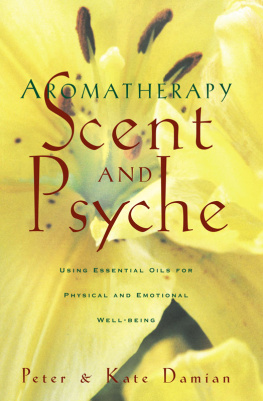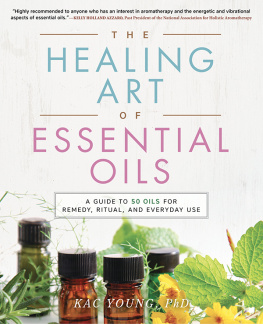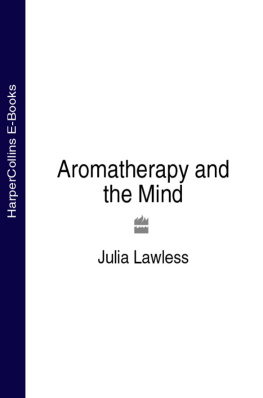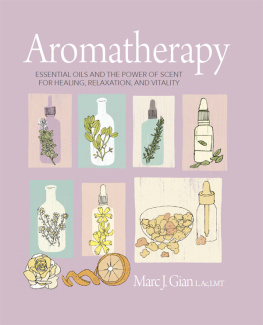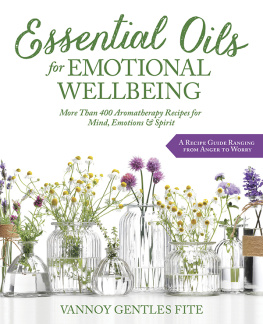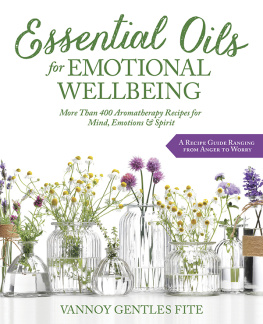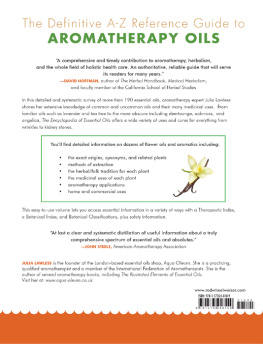
To our parents
Acknowledgments
We express our sincere gratitude and appreciation to friends and associates whose brilliant work and pioneering efforts in the field of phytoaromatherapy have been inspirational; especially Robert Tisserand, Marcel Lavabre, Kurt Schnaubelt, Annemarie Buhler, Dr. Jean-Claude Lapraz, and Dr. Daniel Penoel.
Introduction To Aromatherapy
DEFINITIONS, EXPLANATIONS, FEATURES
Aromatherapy is a modern term for what are actually various therapeutic and aesthetic uses made of derivatives or extracts from a wide variety of plants. More precisely, aromatherapy is the specific use of pure essential oils by topical (skin) application or inhalation. A pure essential oil is the condensation of a plants vital essencethe soul of the plantin which is stored vital solar energy. This essential oil is what gives the plant its fragrance. It is also where the plants most valuable therapeutic and nutritional properties are highly concentrated. The essence is produced by special cells within the plant and contains, among other things, phytohormones: chemical messengers that, like human hormones, transmit cellular information throughout the body in response to stress and environmental conditions. The essence or essential oil protects the plant from disease, parasites, and other would-be predators, while attracting certain insects for reproductive pollination. In some cases, essential oils act as selective weed-killers, allowing the plant to establish its territory by eliminating competitive vegetation. In harsh desert climates, myrrh and frankincense actually emit essential oil vapors to shield themselves from extreme sunlight.
The vital essences of plants are converted into pure essential oils and aromatic hydrosols (floral waters) by the mechanical process of steam distillation. Only after extraction by the production method of distillation does an essence become an essential oil. Although we generally use the term essential oil to describe all the oils employed by aromatherapy, those that are extracted by other methods are not precisely pure essential oils. For example, oils extracted by expression (cold pressing or pressure) retain more of the plants essence. Some plants (e.g., jasmine) will not release their oil unless a solvent is used. Oils obtained by such processes involving chemical solvents are called concrtes or absolutes. These and other production methods will be explained in chapter 6. For now it is enough to know that essential oils can be extracted from certain trees, shrubs, herbs, flowers, and grasses, wherein they may be found in virtually any part of the plant: seeds, flowers, fruit, leaves, stalks and stems, roots, bark, wood, needles, and resins.
The proportional yield of essential oil from plants will vary from a small fraction of 1 percent to as much as 10 percent. The process can be slow, laborious, and quite expensive. It takes 500 pounds of sage or rosemary to make a quart of oil; a ton of thyme will yield less than a quart. It may take thousands of pounds of rose petals to solvent-extract a pound of rose oil. More than 8 million hand-picked jasmine blossoms may produce a mere kilogram (2.2 pounds) of essential oil. (Jasmine and rose are two of the most costly essential oils.) The amount of plant material and the production time requiredor allowedto produce an essential oil will affect its cost and quality. Slow-distilling 1 kilogram of oil from 1,000 kilograms of prime-picked flowers will add to the cost of the oil as well as to the higher-quality concentration of its therapeutic and nutritional constituents and properties.
Most essential oils are colorless or pale yellow; some (e.g., German or blue chamomile) are deeply pigmented. The majority of colored oils (e.g., bergamot and jasmine) are either essences or absolutes. Although highly concentrated, essential oils are not oily. Lighter than water (with a few exceptions), they are usually highly fluid. That they are lipid (fat) soluble rather than water soluble is an important attribute that allows their easier, faster, deeper, and more thorough penetration into the skin. (Since the skin is waterproof, water-soluble substances are resisted.) The rapid skin absorbency of essential oils is also partly due to their highly volatile (evaporative) nature. The characteristics of essential oil molecules allow their ready passage into the bloodstream. Because of their volatility, essential oils are best packaged in airtight aluminum or amber glass containers, which should also be kept in cool, dark, dry storage.
A more inclusive term, phytotherapyplant therapy, or plant medicinebetter describes the varied treatment applications using plant extracts and materials other than, and including, essential oils. Phytotherapy incorporates the internal use of essential oils, principally by ingestion. The term phytotherapy is often combined with, or used interchangeably for, aromatherapy. However, it is just as applicable as a synonym for herbalism or herbology.
Additional methods of extraction that do not produce essential oils, such as the creation of tinctures or liniments, are included in phytotherapy. Two others are decoction (boiling of leaves or roots to gain an extract) and infusion (pouring hot water over herbs or flowers, then briefly steeping them much as one makes tea). Likewise, an infusion oil can be created by soaking aromatic plant material in vegetable oil, thereby infusing the oil with the plants fragrance. This is an ancient technique in the practice of aromatics.
Aromatics is the aesthetic or therapeutic use of scents and fragrances that are derived from plants but are not necessarily essential oils. Ancient aromatherapy practiced prior to the discovery or general implementation of distillation (and therefore of pure essential oils) is more appropriately considered aromatics. Aromatics ought not be confused with simple perfumery involving fragrances that largely contain synthetic oils or scents diluted in alcohol and water, which merely smell pleasant or mask other odors. Personal anointment with infused oils was understood to provide genuine health benefits as well as aesthetic appeal and, moreover, to confer protection from contagious disease, owing in part to the antimicrobial powers of the natural botanical ingredients.
HISTORICAL OVERVIEW
Although the term aromatherapy has been in use for less than a century, the therapeutic, spiritual (religious and liturgical), and cosmetic uses of aromatic oils have at least a 5,000-year history. Phytotherapy or herbology has surely been practiced even longer. The spread of aromatherapy (aromatics, phytotherapy) has followed the westward course of civilization, beginning in the oriental cultures of China, India, Persia, and Egypt. The earliest scriptures of the Hindu religionthe Vedasmention several hundred perfumes and aromatic products, codifying them for both liturgical and therapeutic practices. This knowledge has been maintained for at least 3,000 years through the Indian practice of Ayurvedic medicine, in which many of the essential oils used in aromatherapy have been a useful part. A principal feature of Ayurvedic medicine is aromatic massage using infused oils made from indigenous herbs and woods. The ancient Chinese also advocated massage. The oldest surviving medical texts from China, each dating back to c. 2700 B.C., are classics of herbal medicine. It is very likely that the ancient civilizations of China and India were practicing some form of aromatics as well as phytotherapy while such practices were occurring in Egypt, about which we know considerably more.
The Middle East
Next page
